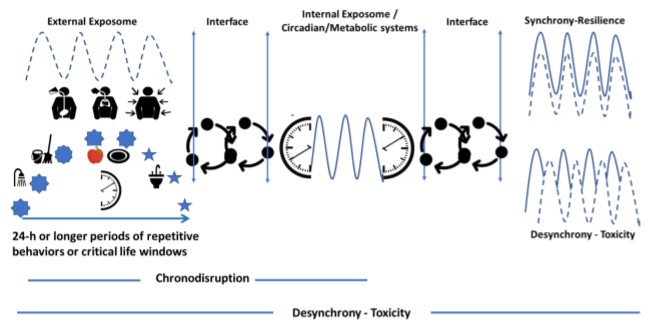Subtitle: The interface of de-synchronized circadian clock and exposures to xenobiotics would lead to adverse biological response and its resolution
This essay provides with the foundations needed for valuing the interfacial synchronization between interacting systems and processes as part of the exposure-outcome continuum assessment in related fields, including but not limited to, environmental epidemiology, toxicology, and precision medicine. A paradigm shift is implicated with increasing our fundamental understanding of xenobiotics’ and other environmental stressors’ chronotoxicity on human health, by considering the circadian or 24-h diurnal disruptions and interfacial desynchronizations between the external time and the internal circadian time likely causing excess toxicity risk. It is of importance to note that both interacting systems at their interface must be studied to effectively shed light on the perturbed biological processes using targeted or untargeted biomarkers of effect/response. The systematic incorporation of the dimensions of synchronization and chronos into observational or experimental studies would potentially shed light on the interplay of circadian periodicity with enzymatic activity and regulation of xenobiotics metabolism and downstream health outcomes. Chronotoxicity evidence would also find use in studies of sick population groups and/or in different age groups towards further disentangling key influences of circadian rhythms on xenobiotics metabolism and their interaction with unique chronotypes or disease outcomes and their progressing stages of severity. This would inevitably lead to improved population-based disease prevention strategies, and policies for advanced drug delivery efficiency. Further, accounting for individual circadian rhythms or personalized nutrition schemes (e.g., restricted feeding)[60, 61] could offer individualized nutrition interventions, obesity treatments, and preventive or therapeutic overall approaches for metabolic and other chronic disorders. Differential sensitivities to time- varying xenobiotics exposures during a day or during a critical lifetime window phase may impose a departing from the median health risk for sensitive individuals, thus, risk assessment approaches could take these susceptible groups into consideration while formulating public health preventive strategies.
Keywords: exposome, synchronization, diurnal, critical life stage, circadian, chronobiology, chronotoxicology, public health

Figure 1. Schematic of the synchronization aspects of the interface linking external exposome lifetime windows, such as, 24-h or periods of repetitive behaviors or critical life windows with the periodic resilience of circadian oscillators and metabolic regulators and that of downstream biological systems and processes (internal exposome); being in sync or not, these interfacial synchronization processes may lead to resilience, or alternatively to patterns of desynchronization and excess toxicity.

